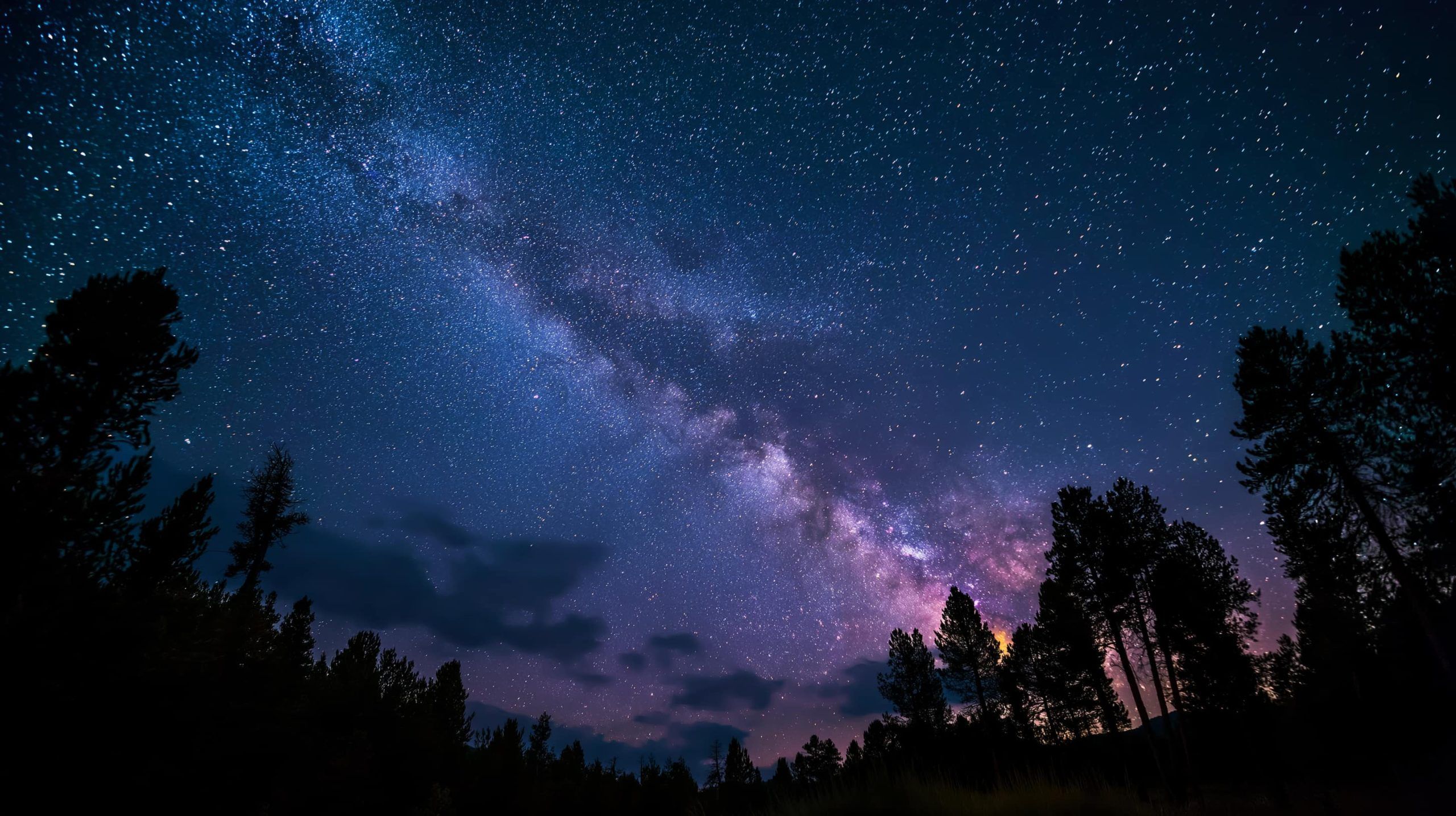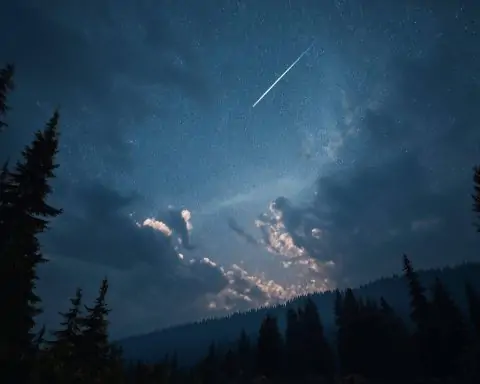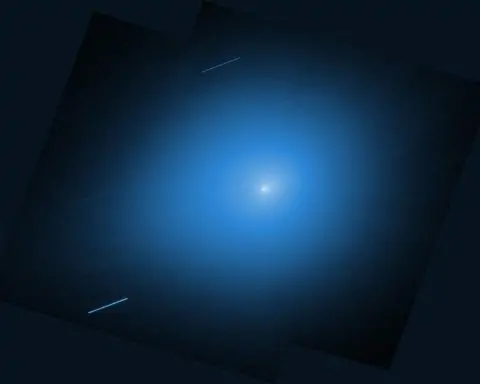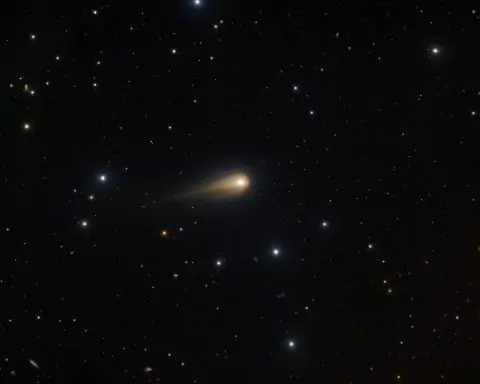- Perseid meteor shower peaks August 11–12 (into the pre-dawn hours) with an 84% full Moon washing out fainter meteors, so expected rates drop to about 10–20 per hour instead of the usual 50–100.
- The best viewing window is midnight to dawn, with a peak surge around 2–3 a.m. local time as the Perseid radiant in Perseus climbs high.
- Fireballs may still appear, and occasional long-lasting earthgrazers could skim the atmosphere early in the night even under moonlight.
- Venus and Jupiter form a close dawn conjunction on August 11–12, about 1 degree apart, visible to the naked eye about 1–2 hours before sunrise.
- Mercury is emerging in the morning sky around August 11–12 but stays very low (under 10°) and may be spotted about 30–40 minutes before sunrise with a flat eastern horizon.
- Mars is a modest evening object, visible low in the west after sunset and about as bright as the Big Dipper’s stars, setting roughly 2 hours after sunset.
- Saturn rises in the east by about 10:30 p.m., is visible all night, and approaches opposition in a few weeks, with its rings visible in a telescope or even hints with binoculars.
- The Moon is waning gibbous on Aug 11–12, rising around 9:30–10:00 p.m., bright enough to wash out faint objects, and a total lunar eclipse of 82 minutes occurs on Sept 7, 2025 across Asia and Western Australia.
- The International Space Station will have several passes around Aug 11–12, typically within a few hours after sunrise or before sunset, lasting only a few minutes each, and viewing can be aided by NASA’s Spot the Station tool.
- SpaceX Starlink launches a Falcon 9 carrying 24 Starlink satellites at 10:05 p.m. EDT on Aug 11 from Florida, with 24 Amazon Kuiper satellites launched on Aug 11 at 8:35 a.m. EDT from Cape Canaveral aboard a Falcon 9, SpaceX’s 100th mission of 2025.
Perseid Meteor Shower Peaks (Under Bright Moonlight): The famous Perseid meteor shower is reaching its peak on the nights of August 11–12 (into the pre-dawn hours of August 13). Normally the Perseids can produce 50–100 “shooting stars” per hour under dark skies, but this year a glaring 84% full Moon will be in the way [1]. The waning gibbous moon rises in late evening and will wash out many of the fainter meteors. “The average person under dark skies could see somewhere between 40 and 50 Perseids per hour” in a moonless year, explains Bill Cooke of NASA’s Meteoroid Environment Office. “Instead, you’re probably going to see 10 to 20 per hour or fewer, and that’s because we have a bright Moon in the sky washing out the fainter meteors” [2]. In other words, expect only ~25% of the usual meteors – but don’t be discouraged! The Perseids are famous for producing “fireballs,” exceptionally bright meteors capable of rivaling Venus’s brilliance and even casting shadows [3]. These extra-bright meteors can punch through the moonlight, so keep watching for the occasional spectacular streak.
Viewing Tips: To maximize your meteor count, you’ll need patience and a late bedtime. “You’re not going to see Perseids around suppertime,” Cooke quips. “You’re going to have to go out later” [4]. The best time is from midnight to dawn, with a peak surge often around 2–3 a.m. local time [5] when the Perseid radiant (in Perseus) climbs high. Find a safe, dark location away from city lights, with a wide view of the sky. Get cozy on a lawn chair or blanket (bring a hot drink!) and give your eyes time to adapt to the dark. Crucially, avoid staring at the Moon – its glare will ruin your night vision. As Cooke advises meteor-watchers: “Look anywhere but at the Moon” [6]. Instead, face the darkest part of your sky (perhaps with the Moon behind you) and scan about halfway up from the horizon. Meteors can appear in any part of the sky, so a broad view helps. Even with the Moon out, you may still catch ~10+ meteors per hour in the pre-dawn hours [7] – and possibly a few long-lasting “earthgrazer” meteors skimming the atmosphere earlier in the night, just after dusk when the radiant is low [8]. Stay alert for any bright fireballs which will be the real show-stealers this year. “A few bright meteors may still be seen in the pre-dawn hours, but viewing conditions are not ideal this year,” NASA reports bluntly [9] – so plan accordingly, and enjoy any Perseid you do catch!
Venus and Jupiter’s Dazzling Dawn Conjunction: Early risers on August 12 are in for a planetary treat – the two brightest planets in the sky, Venus and Jupiter, will cozy up in a spectacular conjunction. In the eastern pre-dawn sky, brilliant Venus and golden Jupiter appear side by side, only ~1 degree apart at closest approach on Aug 11–12 [10]. That’s an incredibly tight apparent pairing – if you hold out your pinky finger at arm’s length, you could cover both planets at once [11]! This “cosmic kiss” of Venus and Jupiter has skywatchers excited, as such close pairings of major planets are relatively rare. “The two planets will shine bright together at just a degree apart on August 11 and 12,” according to NASA [12], creating a brilliant double beacon in the dawn. To see it, look east about 1–2 hours before sunrise on Monday and Tuesday morning. Venus is the intensely bright “Morning Star” lower in the sky, while Jupiter will be nearby and slightly dimmer (but still very bright). No telescope is needed – these planets will gleam plainly to the naked eye, though binoculars could give a pretty two-in-one field of view. Enjoy the sight of our solar system’s two brightest planets nearly touching. They will drift apart in the days after, but stay fairly close for the rest of the month. (Mark your calendar: on August 19–20 a slender crescent Moon will join Venus and Jupiter in this part of the sky, forming a lovely triangle before dawn [13].)
Planets on Parade from Dusk till Dawn: In addition to the Venus-Jupiter duo, several other planets are visible these nights if you know when and where to look:
- Mercury – The elusive Mercury is just beginning to emerge in the morning sky. By mid/late August it will peek above the eastern horizon before sunrise, but around Aug 11–12 it remains very low (under 10° high) and may be hard to spot in the brightening dawn [14]. If you have a flat eastern view, you might try for a tiny twinkle of Mercury about 30–40 minutes before sunrise, but don’t be surprised if it’s too faint in the twilight glow.
- Mars – Mars is a modest evening object right now. Look low in the west after sunset, during twilight and the first hour of darkness, to catch a faint orange-red point of light [15]. It’s only about as bright as the Big Dipper’s stars at the moment, so you may need to mentally separate it from the background stars. Mars sets relatively early (within ~2 hours after sunset), so timing is key. By August’s end Mars will sink into the Sun’s glare, so enjoy your last glimpse now of the Red Planet for this season.
- Saturn – Saturn is rising in the east by late evening and is visible all night. In early August it comes up around 10:30 p.m., and by dawn it will be high in the southern sky [16]. The ringed planet is approaching opposition (closest approach to Earth) in a few weeks, so it’s shining at one of its brightest points of the year (though still much fainter than Jupiter or Venus). You can find Saturn in the constellation Aquarius, glowing with a steady, yellowish light. It will reach its highest point in the south around 4–5 a.m. For the best view, grab a telescope if you have one – even a small scope will reveal Saturn’s iconic rings. In fact, Saturn is currently close enough that binoculars might just barely hint at something odd about its shape (the rings) if held steady. Don’t miss Saturn this month, as it’s truly a joy to observe when it’s so favorably placed.
(Jupiter and Venus have already been covered above – Jupiter is with Venus in the morning east, and aside from that pairing it will continue to rise a bit earlier each week. By midnight, Jupiter is not yet up in early August, but by 3–4 a.m. it’s well above the eastern horizon, following Venus.)
Moon and Upcoming Eclipse: The Moon is a key player this week. It just turned full (the Sturgeon Moon) on August 9, and by Aug 11–12 it is a waning gibbous still shining very brightly most of the night [17] [18]. Moonrise on Aug 11 comes around 9:30–10:00 p.m. (depending on your location), and the Moon will remain up through dawn, flooding the sky with light. Unfortunately, this means no dark, moonless hours during the peak meteor period – which, as discussed, will cut down meteor counts. The moonlight will also reduce the visibility of faint deep-sky objects. If you’re stargazing, plan to target brighter objects (planets, bright stars, or maybe the Summer Triangle’s showpiece nebula M27 which can still be glimpsed despite the moon [19]). There is no eclipse occurring on these dates – the Moon’s brightness will not diminish at all (aside from its natural daily waning). But you can look forward to a dramatic “Blood Moon” total lunar eclipse next month. On September 7, 2025, Earth will cast its shadow over the Moon, resulting in a total lunar eclipse visible across a wide area. Skywatchers in Asia and Western Australia will get the best view of the full 82-minute totality, but those in Europe, Africa, and parts of eastern Australia/New Zealand will also catch at least some of the eclipse (including totality in many of those regions) [20] [21]. This will be the second total lunar eclipse of 2025, and it should be a spectacle as the Moon turns coppery-red in Earth’s shadow. So, while no eclipse graces the nights of Aug 11–12, mark your calendar for Sept 7 – a lunar show is on the way! (And in case you’re wondering, the next solar eclipse is a partial eclipse on Sept 21, 2025 [22], visible from parts of the Northern Hemisphere – interesting, but not as striking as the total lunar eclipse before it.)
Spot the International Space Station (ISS): The ISS will be making several flyovers this week that alert skywatchers can catch. The ISS orbits Earth every ~90 minutes, so it passes overhead multiple times a day – but you can only see it when conditions are right. NASA notes that “all International Space Station sightings will occur within a few hours before or after sunrise or sunset”, when the station is sunlit against a dark sky [23]. In other words, dusk and dawn are prime time. During the middle of the night the ISS is in Earth’s shadow and invisible. Around August 11–12, many mid-northern latitude locations are seeing ISS passes in the predawn hours, while mid-southern latitudes have better evening passes – this pattern shifts over time. To find out if/when the ISS will fly over your area, you can use NASA’s Spot the Station tool or app, which provides customized viewing schedules for countless cities [24] [25]. Generally, an ISS sighting looks like a very bright, fast-moving “star” gliding across the sky. It typically appears in the west or northwest and travels in a smooth arc to disappear in the east or southeast (exact directions vary by pass). The station doesn’t blink or have colored lights like a plane, and it moves much faster – completing an arc across the sky in a few minutes. “The space station appears similar to an airplane or a very bright star moving across the night sky, except it does not have flashing lights or change direction,” NASA explains [26]. If you catch a pass at its highest point, the ISS can outshine most stars and even rival Venus in brilliance! Each visible pass lasts only a few minutes at most, so when you get a prediction, be sure to be outside on time and looking in the right direction. Pro tip: if you see one bright pass, wait ~90 minutes and you might spot a second pass on the same night as the ISS loops around again (though the second pass is often shorter or lower in the sky). Tracking the ISS is a fun activity for kids and adults alike – essentially watching a spaceship with humans on board soar ~400 km above us at 28,000 km/h (17,500 mph) [27]. It never gets old to spot!
Satellite Sleuthing – Starlink “Train” and More: In addition to the ISS, you might notice other satellites moving across the sky after dusk or before dawn. One timely example is SpaceX’s Starlink satellites, which sometimes create a noticeable “train” of lights after a launch. In fact, SpaceX is conducting a launch on the night of Aug 11–12 specifically for its Starlink network. At 10:05 p.m. EDT on Aug 11 (02:05 GMT Aug 12), a Falcon 9 rocket is scheduled to lift off from Florida carrying 24 new Starlink internet satellites into orbit [28]. If you live in Florida or along the southeast U.S. coast, there’s a chance you might see the rocket’s bright ascent low on the horizon shortly after 10 pm (weather permitting) – appearing as a fast-moving streak of light. For those not near the launch site, fear not: a day or two after launch, the batch of Starlink satellites themselves may become visible. When first released in orbit, they travel in a closely spaced line, often reported as a eerie “string of stars” moving together across the sky. These Starlink satellite trains look like a line of bright dots gliding one after the other [29]. They are usually best seen in the evening an hour or two after sunset (or similarly before dawn), when the satellites are catching sunlight against a dark sky. Keep an eye out for any reports of a satellite train in your area in the nights following August 11/12. (They gradually spread out and dim over the course of a week or so.) On a related note, Amazon’s Project Kuiper – a new satellite internet constellation – also has a launch this week: on Aug 11 at 8:35 a.m. EDT, Amazon launched 24 Kuiper satellites aboard a SpaceX Falcon 9 from Cape Canaveral [30] [31]. That was SpaceX’s 100th mission of 2025, underscoring how busy our skies are getting. The Kuiper satellites are not as numerous yet as Starlink, but they add to the growing population of spacecraft overhead.
In the News: Comets and Other Curiosities – No bright comets are currently visible to the naked eye this week, but astronomers are keeping tabs on a few faint comets in telescopes. (For instance, Comet 12P/Pons-Brooks made headlines in 2024 for an outburst, but it’s not visible without large telescopes in August 2025.) Meanwhile, NASA is studying an intriguing “interstellar comet” – a visitor from another star – via the Hubble Space Telescope [32], but again this object is far beyond naked-eye visibility. As for other sky phenomena: if you’re far north, you might watch for auroras (the northern lights) on any given night, as the Sun has been active lately – space weather forecasts can hint if auroral activity is expected. And if you have binoculars or a telescope, August evenings are a great time to tour the Summer Triangle overhead – for example, try spotting the pretty Dumbbell Nebula (M27) in the constellation Vulpecula, which NASA notes is one of the easiest planetary nebulas to observe and is high in the summer sky this month [33]. There’s always something to marvel at in the night sky, even on moonlit nights.
Clear Skies! Whether you’re chasing meteors after midnight, admiring a planetary conjunction at dawn, or simply gazing at the Moon and stars, the nights of August 11–12, 2025, offer a bit of cosmic wonder for everyone. Dress warmly (summer nights can still get chilly pre-dawn), bring a friend or family member for shared stargazing, and enjoy the show nature is putting on above. And if clouds spoil your view tonight, don’t worry – the Perseids will continue (with gradually fewer meteors) for a week, and the planets will continue their dance. Keep looking up, and happy skywatching! (Sources: NASA, EarthSky, Space.com, AMS and others [34] [35] [36] [37] [38])
References
1. science.nasa.gov, 2. www.nasa.gov, 3. www.euronews.com, 4. www.nasa.gov, 5. www.nasa.gov, 6. www.nasa.gov, 7. www.nasa.gov, 8. www.amsmeteors.org, 9. www.chron.com, 10. science.nasa.gov, 11. earthsky.org, 12. www.chron.com, 13. science.nasa.gov, 14. science.nasa.gov, 15. science.nasa.gov, 16. science.nasa.gov, 17. earthsky.org, 18. www.chron.com, 19. www.chron.com, 20. www.space.com, 21. www.space.com, 22. www.timeanddate.com, 23. www.nasa.gov, 24. www.nasa.gov, 25. www.nasa.gov, 26. www.nasa.gov, 27. www.nasa.gov, 28. starwalk.space, 29. starwalk.space, 30. www.space.com, 31. www.space.com, 32. science.nasa.gov, 33. science.nasa.gov, 34. www.nasa.gov, 35. science.nasa.gov, 36. www.chron.com, 37. science.nasa.gov, 38. www.euronews.com










